Navigating the FinOps M&A Era
Enterprise IT teams rely heavily on technology and vendor relationships to ensure success. These partnerships not only help solve intricate challenges but also provide the essential tools that businesses demand and assist in scaling operations. The sturdy backbone of modern IT operations often finds itself under threat by frequent mergers and acquisitions in the tech realm. Especially for those enterprises who stay ahead of the curve, it becomes evident how swiftly industry giants often rush to acquire rising vendors, seeking to bolster their own relevance. The world of FinOps isn’t exempt from this reality. In fact, recent acquisitions have made waves in the sector, leaving many Apptio customers wondering what’s next and looking for Cloudability alternatives.
For those of us who have watched this play out many times before, here is some advice for Cloudability customers who fear the worst:
Know the History
The cloud landscape, especially in the realm of FinOps, has seen numerous shifts and turns. The most recent spectacle was when IBM acquired Apptio for a staggering $5 billion – setting a new benchmark for CCMO tools. Yet, this isn’t IBM’s first venture into the acquisition spree. It’s worth noting that the tech giant has made several strategic investments in the past. Be it the acquisition of Nordcloud & Klarity Core in 2020 or the purchase of Turbonomic in 2021, IBM has consistently shown its appetite for expansion. Whether there is a broader strategy remains to be seen. It’s not just IBM; giants like VMware, NetApp, and even Cisco have also made their moves in the market. With such a dynamic past, it becomes paramount to stay updated and be proactive rather than reactive.
Recognize the Early Signs of Acquisition Ripples
Mergers and acquisitions, while potentially lucrative for the companies involved, can be challenging for customers. With every acquisition, there is often a whirlwind of uncertainties: Will the product vision change? Will there be a shift in focus? Will the pace of innovation slow (or stop altogether)? Will TCO increase? And perhaps the most daunting of all – will there be key resource exits? History shows us that acquisitions can come with their fair share of turmoil. Whether it’s challenges integrating companies or the exit of strategic leaders and partners, the consequences of hasty acquisitions can emerge months, even years, after the deal is inked. But with knowledge and vigilance, enterprises can avoid being caught off-guard.
Consider Proactivity with a Migration Blueprint
If the writing is on the wall, or even if it’s just a hunch or even a seemingly distant possibility, ensure you have a migration plan ready. Transitioning to another platform is a significant decision and necessitates intricate planning:
- Establish Your Cross-Functional Representatives: Involve key stakeholders from various departments.
- Frame the Project for Stakeholders: Clearly communicate the importance and scope of the migration.
- Build a Team of Internal Experts: Ensure you have technical expertise within the company to guide the transition.
- Take Inventory of Used Features: Understand your requirements and ensure no data loss during migration.
- Create a Risk Assessment Report: Understand and communicate all potential challenges and risks associated.
- Determine Technical, Time, and Financial Requirements: Outline the resources needed for a smooth transition.
- Create Project Management System for All Parties: Ensure transparency and seamless communication throughout the migration.
- Perform the Migration in Phases: Undertake the migration systematically to ensure thoroughness.
- Test Cases After Each Phase: Regular testing ensures that problems are identified and addressed promptly.
Scout the FinOps Landscape and Make Informed Choices
It’s important to identify and vet your options ahead of time so that you’re not starting flat-footed if/when the time comes to bail on your existing solution. Know your options and have a perspective on your top choice(s). While the cloud financial management space is crowded with both small players and established vendors, it’s essential to prioritize the features and functionality that align with your organization’s needs. With potential uncertainties around vendors after major acquisitions, such as in Apptio’s case, you might be inclined to choose among Cloudability alternatives that are committed to agility and innovation. CloudBolt, for instance, offers more than just a solution; it provides a partnership. Their commitment to continuous development, agility, and customer-focused innovation makes them an appealing choice for businesses seeking stability in an ever-evolving market.
Your Next Step Forward:
In the rapidly changing world of cloud financial management, it’s vital to stay informed, be proactive, and ensure your enterprise is partnered with vendors who share your vision and commitment. With the right knowledge, preparation, and partners like CloudBolt, you can navigate the FinOps space confidently, maximizing efficiency, and ensuring success in all your cloud endeav ors.
Ready to explore your options?
CloudBolt’s guarantee is to be a stable, dependable partner in this ever-evolving space. We know that businesses require a cost management partner that remains consistent in their approach and values. That’s CloudBolt. With us, there are no unexpected shifts or strategic surprises—just agile, customer-focused development designed to lead the market and align with your needs.
If you’re ready to proactively start exploring or if you’ve already made up your mind to move away from your existing solution, please consider CloudBolt to ensure your cloud strategy remains uninterrupted in these turbulent times!
Are you looking for Cloudability alternatives?
Learn the real difference between Cloudability and CloudBolt
Book your demo today and see for yourself!
Now more than ever, companies are being asked to “do more with less.” Less people. Less budget. The phrase has become so overused these days that some workers bristle any time they hear it; others tune it out altogether. So, it is no surprise that the need for ITOps, DevOps, CloudOps, FinOps, and SecOps to properly leverage automation for cloud-related operations and processes has become more than just lip service. But are companies operating in vastly inefficient ways because they lack a “home for automations” – a central repository for best “automations” and elements that can be shared and re-used system-wide across team and regions?
This CII (CloudBolt Industry Insights) report was designed to gauge the reality of silos of automation across enterprises. Do they leave disparate groups re-inventing the same solutions to common problems? Are these groups completely unaware that someone else may have previously developed a best practice/approved approach to a given automation challenge? And how prevalent is the problem and the related issues?
Using Gartner’s Pulse Survey Platform in late 2022, we received responses from 350 senior IT and DevOps leaders at companies with more than 5,000 employees globally (download the full PDF for a more detailed audience break-down and complete survey data). Respondents’ answers make one thing very clear: the home for automations remains a siloed mess.
The Salient Six: 6 Things You Need to Know
1. Tool Overload
Respondents across the representative sample confirm that to varying degrees they are using one or more of TWENTY-SEVEN DIFFERENT AUTOMATION TOOLS – with none of them being mentioned for more than 31% of the sample! And that doesn’t even include custom code or “other.” (Interestingly, with all the buzz about automation-related tools like Ansible Tower and Terraform Enterprise, the numbers bear out that Puppet and Chef are still more popular. And the single most often cited was RedHat Kickstart at 31%.)
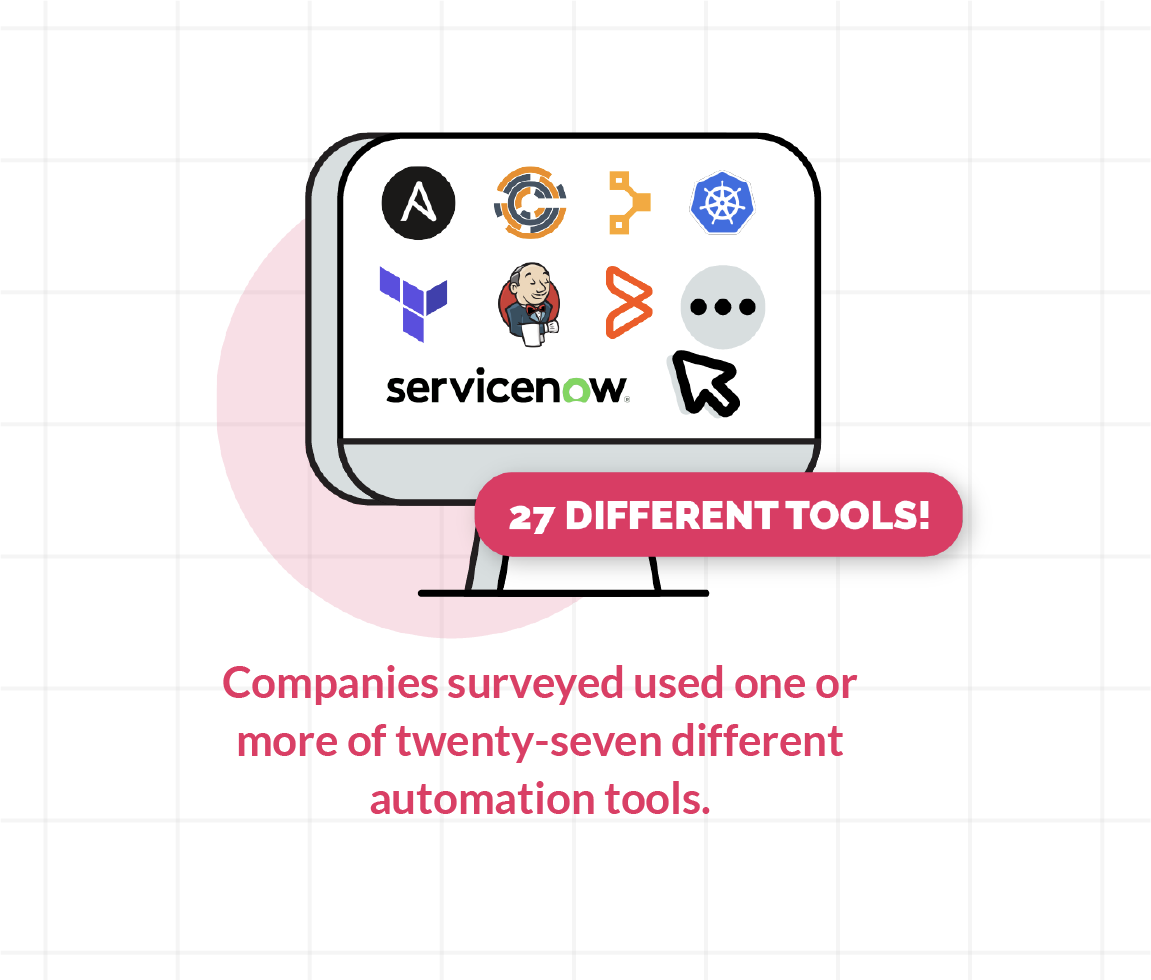
2. My Team Isn’t Siloed
57% of companies keep automations organized within individual silos. So it’s not surprising that 60% of respondents think their current siloed approach makes it easy for them to find and use/re-use what they need, when they need it. Furthermore, given the individual silos, 73% said their current approach ensured they are accessing only the latest, approved versions of automation assets they need. But this points to a prevailing myopic view of “I know what I have and I have a pretty good idea where to get it because it lives in my silo.” In the context of other answers and findings in the survey, it is safe to conclude that many may have never contemplated being able to explore a system-wide/enterprise-wide repository of automations people in other groups/departments/locations have developed that could save everyone from wasting time reinventing something that has already been solved. That’s because…
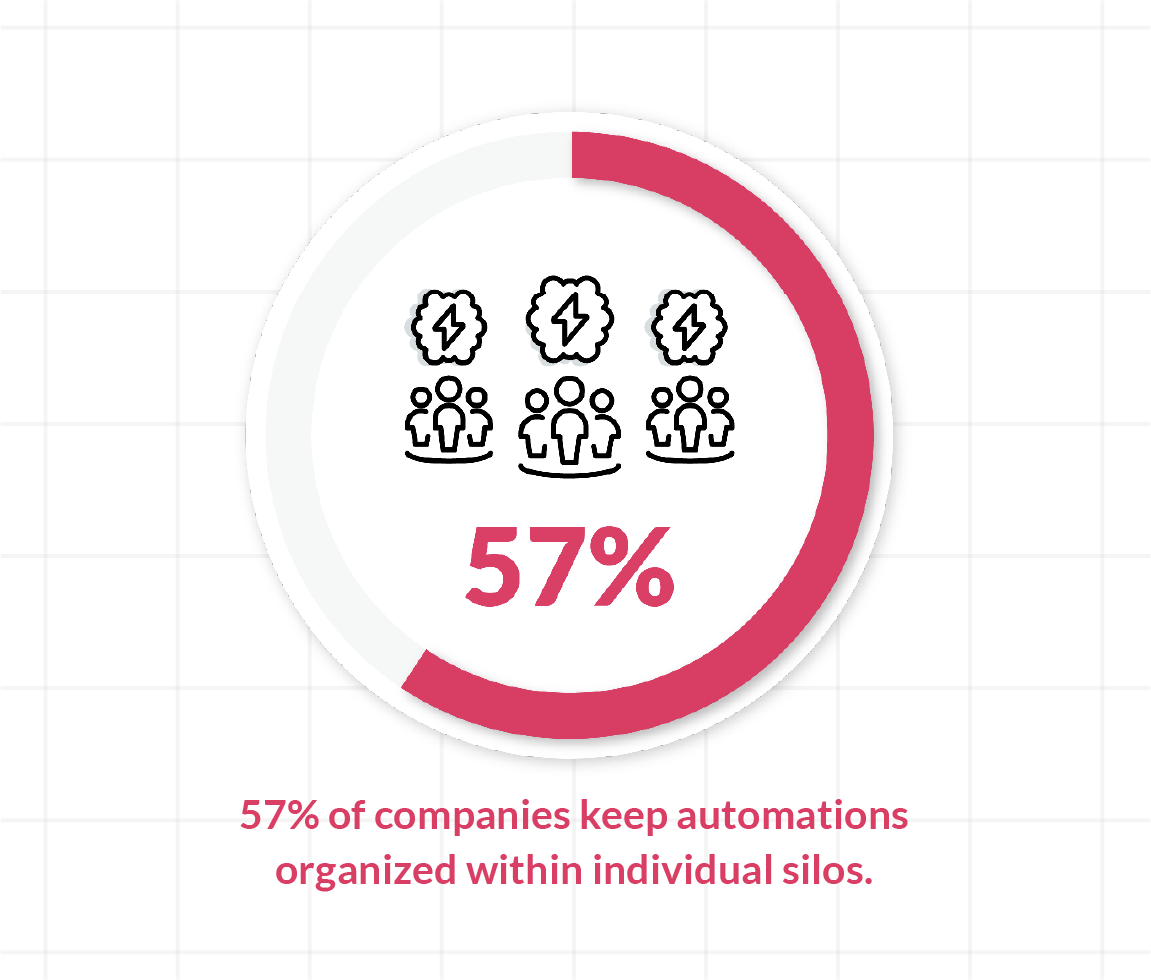
3. Silos of Automation Are the Problem
55% of respondents say they have FOUR OR MORE automations teams across their companies. Only 5% of all companies say these teams are not siloed. And 75% of respondents assert that silos of automation are hampering their ability to unify cloud operations across functions.
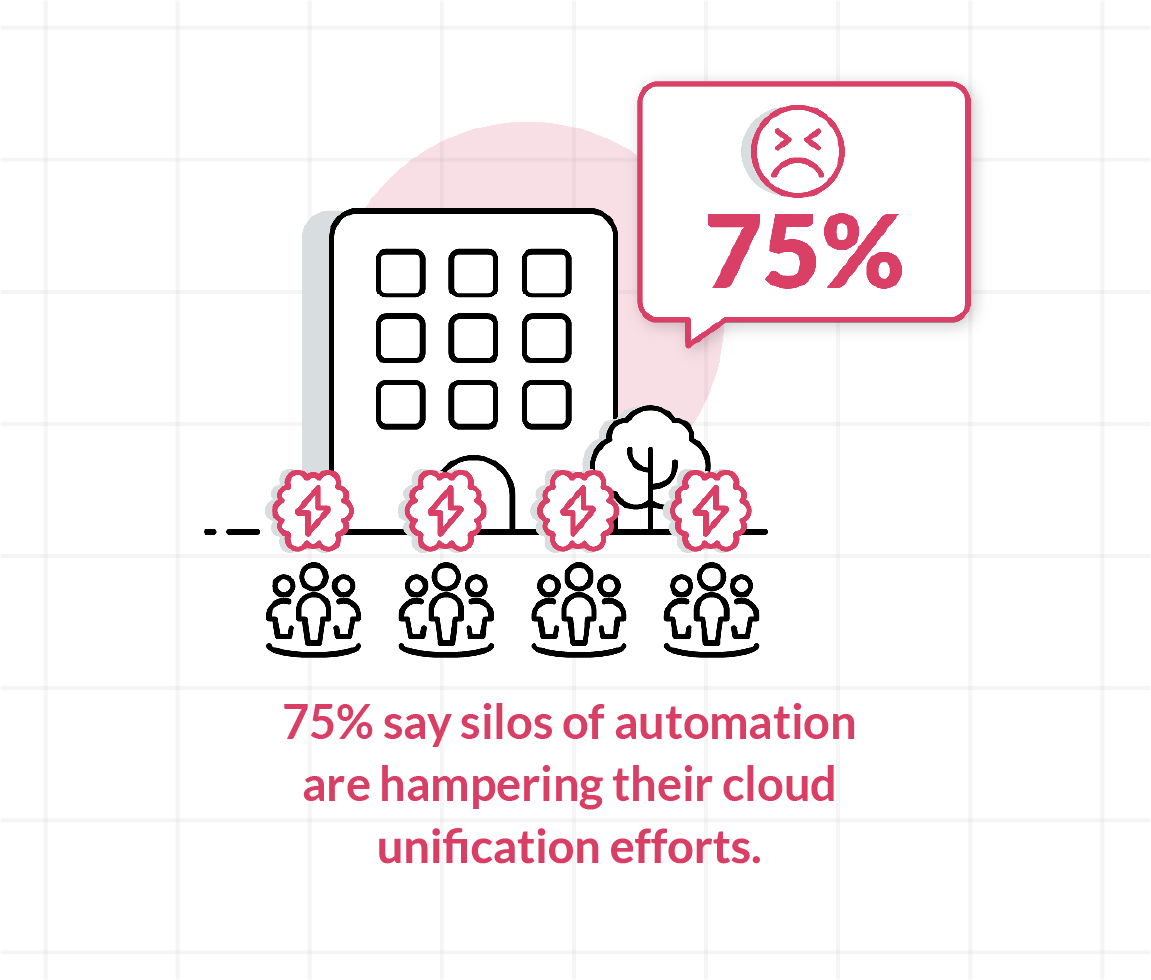
4. Thinking Outside the Silos
When presented with a more holistic option, a near-unanimous 88% of respondents agreed that “it would be valuable to have all legacy and future automations centralized in one place for the entire organization in a way that ensures compliance, increases security, enables business continuity, encourages reuse, and reduces risk.”
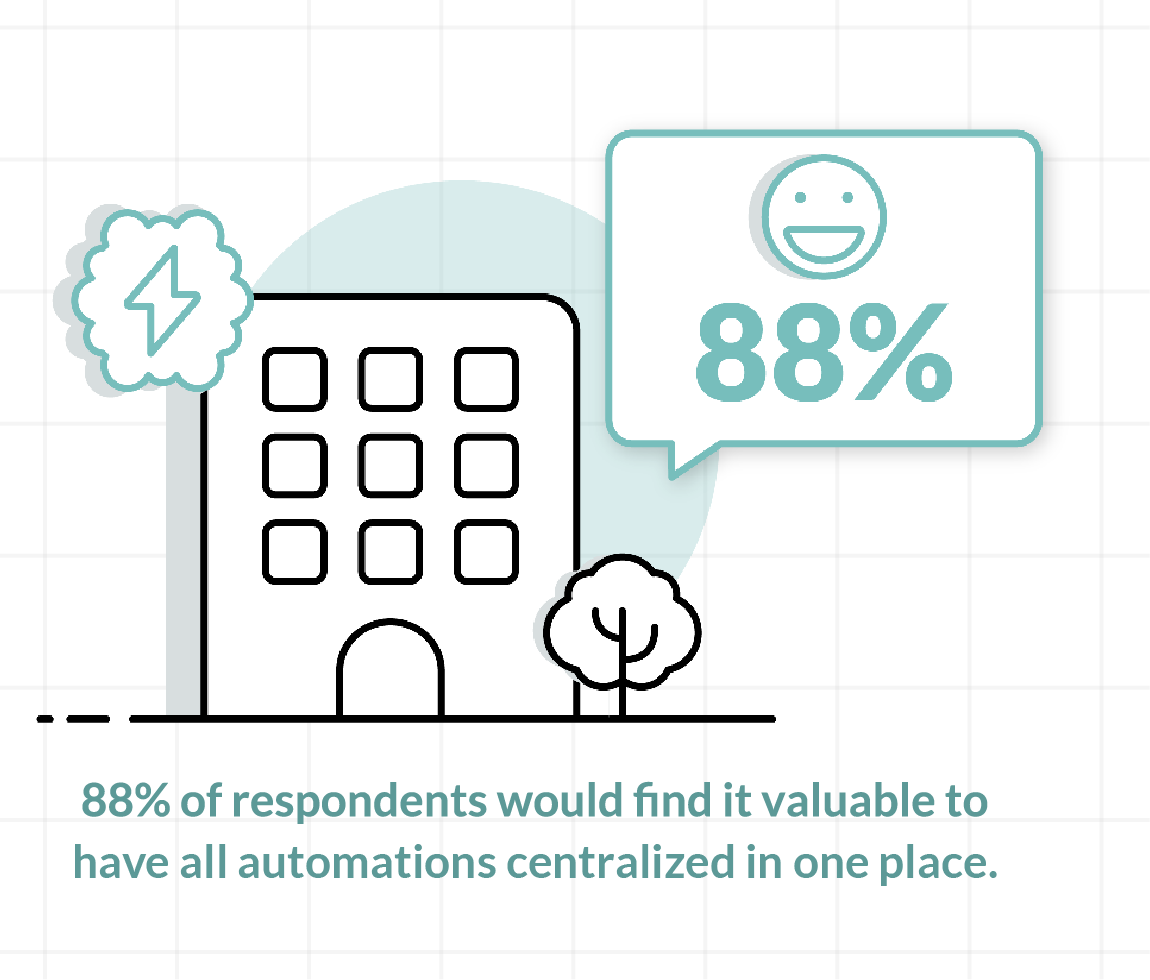
5. Up-and-coming and on the Radar
Since almost 9 of 10 respondents agreed that a centralized home for automations is valuable, it was positive to see that 57% say their companies are trying to do something about it by making it a key initiative or moving in that direction.
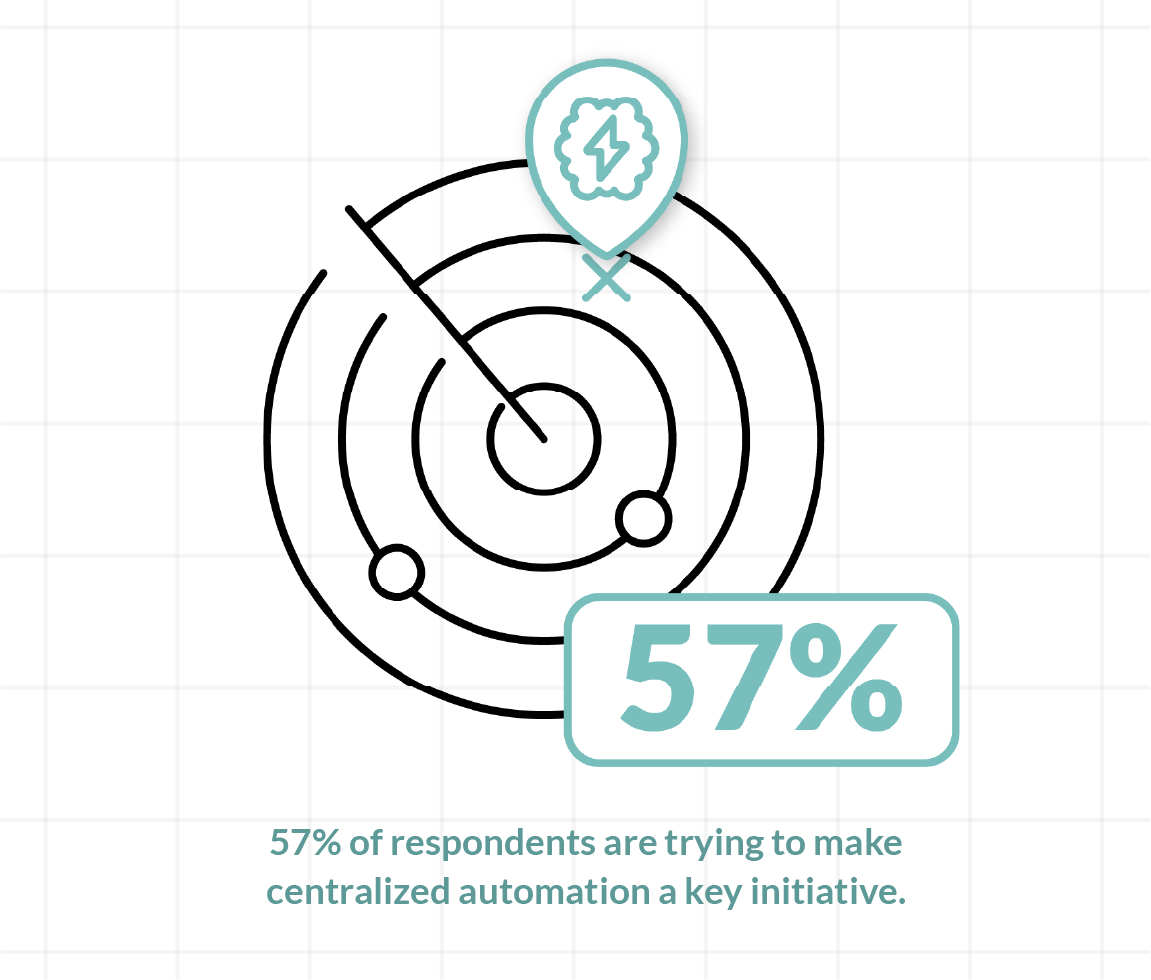
6. A Threat to Business Continuity
Due to a lack of effective automation centralization, among other factors, 77% of respondents agree that business continuity becomes a very real issue any time a key member of the team leaves.
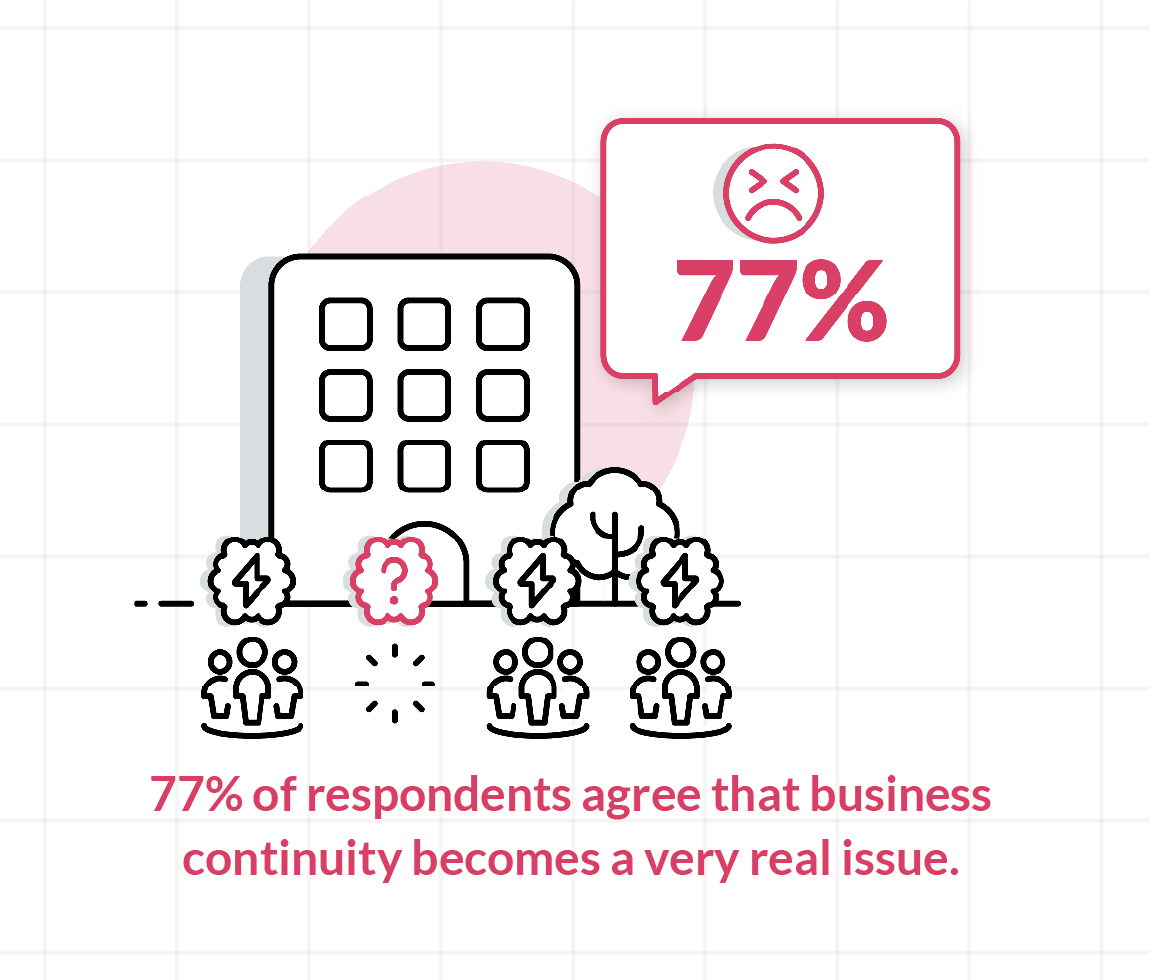
Recommendations
Cloud budgets are being scrutinized. IT and Devs are being asked to do more with less. Companies are now in a world where there is a skills shortage and constraints are preventing companies from hiring additional resources to keep up. It’s a new chapter for Cloud and automation is the answer. However, the only way automation becomes truly scalable and efficient is if there is a “home” where automations can be aggregated and curated enterprise-wide. While that may seem like a daunting task, the good news is that there are clear steps to make progress against this objective:
1. Acknowledge the Automation Silos Are Real – While most groups feel comfortable that they can access and share automations across their siloed teams, the larger promise of enterprise-wide automation efficiencies and reuse will never be realized until companies are willing to admit there is a major gap in the overall connective tissue. The first step in correcting a problem is admitting there is one. As an example, most silos have the same 3-5 manual processes that need to be automated.
2. Establish an Automation Center of Excellence – An automation center of excellence (CoE) includes the people, processes, and technology necessary to maximize the benefits of automation. Additionally, it accelerates collaboration and sharing. The CoE is crucial to finding immediate and longer-term automation opportunities, advising other teams, scaling automation within the organization, and carrying out a long-term vision.
3. Prove Value by Starting with Low-Hanging Fruit – Automation CoEs fail when organizations try to do too much too quickly and solve for everything at once (e.g., boil the ocean). Start with quick wins – pick your 3-5 most common manual automations (e.g., getting access to something). Use the CoE to identify automation scripts, integrations, blueprints, and code that represent duplicate efforts across teams. Once best examples of each are designated and made available (initially via a simple centralized repository), branch out to the work in one area that should be made available to all, and so forth. Then, build processes and procedures for introducing, vetting, promoting, governing, and retiring automations on-going so that best options are always available.
Gall’s Law: Complex processes that work best evolve from simple processes – they are not designed from scratch. Don’t try to automate everything at once – start small and grow.
4. Build a Unified “Automation App Store” – Advance beyond a simple repository to an advanced management system or automation exchange that makes it easy to find, evaluate, and execute proven workflow automations and elements. When done well, this repository serves as a home for automation that reduces friction and encourages both use and contributions.
5. Future State: Leverage Artificial Intelligence – Overlay tools like OpenAI and GitHub Copilot to your automation workflows and repository to make intelligent suggestions, inform needs, spot duplicative efforts, and quickly access desired automations and applicable elements.
Conclusion
Too many tools, too many automations, too many silos, and not enough sharing across enterprises (not just sharing across individual teams) is costing organizations precious time and money through inefficiencies and redundancies. Fully leveraging and accelerating automations in any company depends on the ability to unify disparate pieces of the work into a single repository for reuse – searchable and accessible by all who need it. So far, only 5% of companies are even claiming to do this. But the good news is that a majority (57%) of forward-thinking enterprises are prioritizing making a home for automation a reality.
Optimizing and making automation available enterprise-wide is a key component of achieving maximum value from any cloud strategy. Those who do will achieve definite competitive advantage through acceleration from reuse. Those who do not will lag behind, and whether they will be able to close the gap is unclear.
Want to learn more? See how CloudBolt can help you get the most out of your cloud or talk to an expert.
Guest blog by CloudBolt partner Giacom
→ https://www.giacom.com/news/cloudbolt-powering-growth-through-the-right-relationship/
By Desirre Kaluza, Product Manager at Giacom
In an era where digital transformation is reshaping industries and revolutionising business operations, the importance of choosing the right partner has become a priority over choosing the perfect solution. Because, let’s be honest, there is no perfect solution. Nothing will tick all your boxes, all the time, over time. At least that’s what I believe. And I’m a Product Manager, so I’ll trust my gut on this one.
This is a story about choosing the right partner to support us, Giacom, as a Cloud Distributor.
If you’ve ever sold Azure, you probably came across issues like monitoring usage and being able to show your customers their own spend (and include their own margins). A Cloud Management tool like CloudBolt could solve these. But so could others. So why CloudBolt?
Working with big vendors has its perks, but unless you’re equally big, it often feels like whatever business you do with them is just a drop in the ocean of Enterprise revenue they can get direct. And that extends to communication: strength is in numbers, if you want to make ripples, either you spend big or you count on many SMBs asking for the same.
I already work with Azure, which is a beast of a product, and I wanted a Cost Management vendor Giacom could make a difference with and make a difference to. I wanted to create ripples and see those ripples extending far into their development roadmap and marketing choices. I wanted responsiveness everywhere across their teams and I wanted to feel they cared about what we wanted. I didn’t want the short-lived moment of a “perfect” solution, I wanted the relationship that would enable us to grow together and make the solution tick all our partners’ boxes, most of the time, over time.
From the get-go, CloudBolt have consistently given us a dynamic collaborative space to continuously push forward cutting-edge technology which we consider a must-have for us and our partners. I asked Will Norton, Senior Director of GTM at CloudBolt, how the partnership has changed CloudBolt’s approach, “Giacom helps us see things at scale. We expose ourselves to various scenarios faster than ever rather than taking months as we used to. This accelerates our need to deliver value.”
The partnership wasn’t a game changer for Giacom only. By joining us, CloudBolt took a significant step which opened the door for them to the UK channel market.
Will adds, “The UK operates on a tighter knit community than the US. Word of mouth is vital. Connected conversations count because they build relationships rather than just business transactions. We feel like part of the Giacom team, learning together. We engage in client conversations, observe market trends, and understand what your partners need. These insights fuel our growth and product development. It’s an intimate relationship.”
And that it is. From our multiple calls to look at technical aspects, to our bi-weekly updates which occasionally get interrupted by a child saying hi or a baby crying somewhere in the house, it truly feels like we are in this together. And neither of us are slowing down.
“Over the past year, we have spent considerable time understanding the differing needs of direct partners and MSPs. The UK channel now underpins much of our business strategy,” says Will.
“We aim to offer our other products similarly to how Giacom offers our Cost Management platform. The channel teaches us the importance of efficiency and value delivery over simply reselling.”
Choosing the right partner has serious implications on the future of a commercial strategy. Giacom’s and CloudBolt’s joint focus on a more value-based and outcome-based approach aims to offer partners the hypercare they need to grow their business knowing their feedback actually does make ripples, and that Giacom does listen.